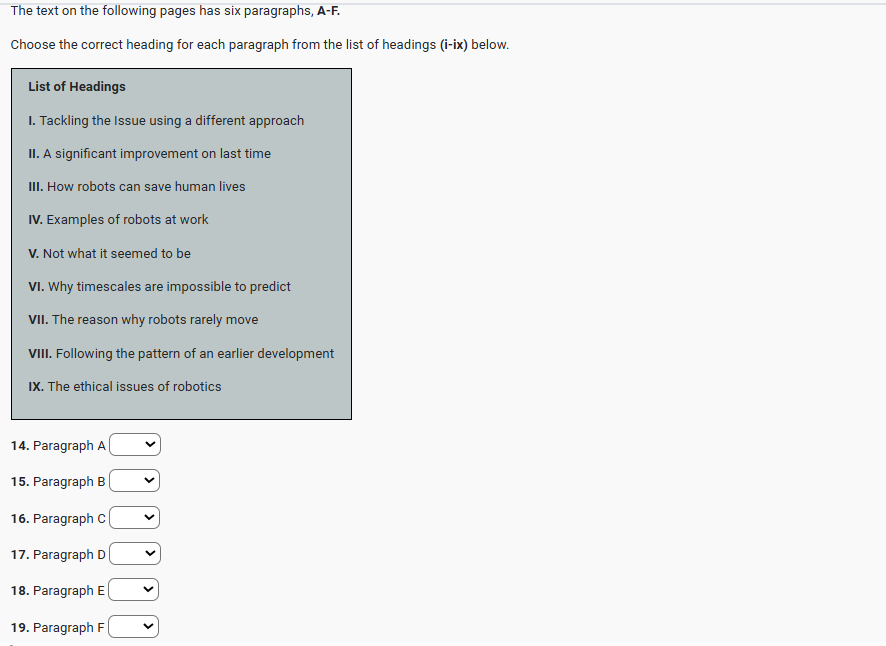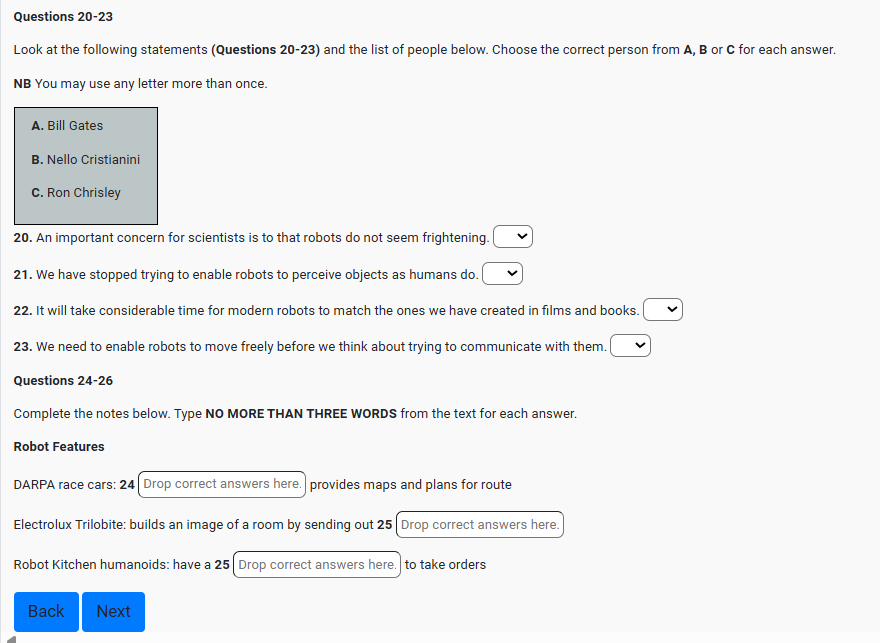| IELTS reading Dawn of the robots reading practice test has 10 questions .. |
They’re already here – driving cars, vacuuming carpets and feeding hospital patients. They may not be walking, talking, human-like sentient beings, but they are clever… and a little creepy.

A. Q14 At first sight it looked like a typical suburban road accident. A Land Rover approached a Chevy Tahoe estate car that had stopped at a kerb; the Land Rover pulled out and tried to pass the Tahoe just as it started off again. There was a crack of fenders and the sound of paintwork being scraped, the kind of minor mishap that occurs on roads thousands of times every day. Normally drivers get out, gesticulate, exchange insurance details and then drive off.

Q14 But not on this occasion. No one got out of the cars for the simple reason that they had no humans inside them; the Tahoe and Land Rover were being controlled by computers competing in November’s DARPA (the U.S. Defence Advanced Research Projects Agency) Urban Challenge.
B. The idea that machines could perform to such standards is startling. Driving is a complex task that takes humans a long time to perfect. Yet here, each car had its Q24 on-board computer loaded with a digital map and route plans, and was instructed to negotiate busy roads; differentiate between pedestrians and stationary objects; determine whether other vehicles were parked or moving off; and handle various parking manoeuvres, which robots turn out to be unexpectedly adept at. Even more striking was the fact that the collision between the robot Land Rover, built by researchers at the Massachusetts Institute of Technology, and the Tahoe, fitted out by Cornell University Artificial Intelligence (AI) experts, was the only scrape in the entire competition. Q15 Yet only three years earlier, at DARPA’s previous driverless car race, every robot competitor – directed to navigate across a stretch of open desert – either crashed or seized up before getting near the finishing line.
C. It is a remarkable transition that has clear implications for the car of the future. More importantly, Q16 it demonstrates how robotics sciences and Artificial Intelligence have progressed in the past few years – a point stressed by Bill Gates, the Microsoft boss who is a convert to these causes. ‘The robotics industry is developing in much the same way the computer business did 30 years ago,’ he argues. As he points out, electronics companies make toys that mimic pets and children with increasing sophistication. Q22 I can envision a future in which robotic devices will become a nearly ubiquitous part of our day-to-day lives,’ says Gates. ‘We may be on the verge of a new era when the PC will get up off the desktop and allow us to see, hear, touch and manipulate objects in places where we are not physically present.’
D. What is the potential for robots and computers in the near future? The fact is we still have a way to go before real robots catch up with their science fiction counterparts/ Gates says. So what are the stumbling blocks? One key difficulty is getting robots to know their place. This has nothing to do with class or etiquette, but concerns the simple issue of positioning. Q17 Humans orient themselves with other objects in a room very easily. Robots find the task almost impossible. ‘Even something as simple as telling the difference between an open door and a window can be tricky for a robot,’ says Gates. This has, until recently, reduced robots to fairly static and cumbersome roles.
E. For a long time, Q18 researchers tried to get round the problem by attempting to re-create the visual processing that goes on in the human cortex. However, that challenge has proved to be singularly exacting and complex. So scientists have turned to simpler alternatives: ‘We have become far more pragmatic in our work,‘ says Nello Cristianini, Professor of Artificial Intelligence at the University of Bristol in England and associate editor of the Journal of Artificial Intelligence Research. Q21 ‘We are no longer trying to re-create human functions. Instead, we are looking for simpler solutions with basic electronic sensors, for example. This approach is exemplified by vacuuming robots such as the Electrolux Trilobite. The Trilobite scuttles around homes emitting Q25 ultra sound signals to create maps of rooms, which are remembered for future cleaning. Technology like this is now changing the face of robotics, says philosopher Ron Chrisley, director of the Centre for Research in Cognitive Science at the University of Sussex in England.
F. Last year, Q19 a new Hong Kong restaurant, Robot Kitchen, opened with a couple of sensor-laden humanoid machines directing customers to their seats. Each possesses a Q26 touchscreen on which orders can be keyed in. The robot then returns with the correct dishes. In Japan, University of Tokyo researchers recently unveiled a kitchen ‘android’ that could wash dishes, pour tea and make a few limited meals. The ultimate aim is to provide robot home helpers for the sick and the elderly, a key concern in a country like Japan where 22 per cent of the population is 65 or older. Over US$1 billion a year is spent on research into robots that will be able to care for the elderly. Q23 ‘Robots first learn basic competence – how to move around a house without bumping into things. Then we can think about teaching them how to interact with humans,’ Chrisley said. Machines such as these take researchers into the field of socialised robotics: Q20 how to make robots act in a way that does not scare or offend individuals. ‘We need to study how robots should approach people, how they should appear. That is going to be a key area for future research,’ adds Chrisles.
Easily Get Required Score I am interested in IELTS Pass with Confidence, Dehradun Small Batch Size with Flexible Time, professional faculty.
![]()
8439000086
8439000087
7055710003
7055710004
IELTS Simulation 323 GMS Road, Near Ballupur Chowk, Dehradun, India
![]()
email: info at ieltsband7.com
Boost Your Score: Practice IELTS Online with IELTS Simulator Prepare for IELTS Effectively Using IELTS Simulator Ace the IELTS: Try Realistic Practice on IELTS Simulator IELTS Simulator: Online Practice to Improve Your IELTS Score Rocky Bay field trip listening practice test has 10 questions belongs to the Leisure & Entertainment subject. Prepare for IELTS IELTS Test International Experienced Teacher Best Training By CELTA Trainer. Best Results Easily Get Required Score IELTS Exam Dates Available, Small Batch Size with Flexible Time, Professional. Easily Get Required Score I am interested in IELTS Pass with Confidence, Dehradun Small Batch Size with Flexible Time, professional faculty. Learn From Experienced Teacher Best IELTS Coaching Dehradun Best IELTS in Dehradun Uttarakhand GMS Road BEST coaching in Dehradun Apply for Class Courses Today Good Results. Small Batch Size, Flexible Time and Professional IELTS Teacher Best IELTS coaching classes IDP certified British Council trained and CELTA certified experienced trainer. Easily Get Required Score Tel:8439000086 Tel:8439000087 Tel:7055710003 Tel:7055710004 Tel:7055710009
